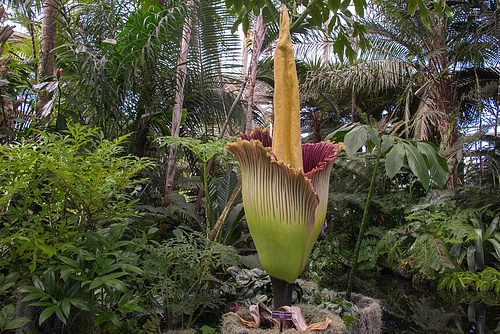
The Corpse Flower was recently in the news. On July 28, the specimen at the New York Botanical Garden was expected to bloom, drawing large crowds. The flower takes about ten years to open, and it is during the rare occurrence of its blossoming, lasting a fleeting three days or so, that its distinctive, cadaverous odour is dispersed.
The sensational event was featured in various media, including two literary magazines—The New Yorker and The Paris Review. The sighting of a larger-than-human flower is one of those opportune occasions, arising few and far between like a passing comet, that inspire writers to try their hand at describing flora without using clichés, and rehashing in new, personalized language, authoritative, causal scientific explanations for overpowering stenches.
But then I saw the same apt word “baguette” used to describe the flower’s spadix in both the New Yorker and Paris Review stories, and both writers Elif Batuman and Kent Russell explaining the flower’s Latin (Russell called it Greek) scientific name, Amorphophallus Titanum, as “giant misshapen phallus” without questioning the translation. That made me wonder how new we could make this story about a legendary fetid flower of mythical dimensions, the complete opposite of Novalis’ Blue Flower that, according to Walter Benjamin, nobody dreams about anymore.
If Wallace Stevens showed us Thirteen Ways of Looking at a Blackbird, in how many ways can we smell a Corpse Flower? Batuman reports that disappointed visitors remarked “on the lack of corpse-like odour” of the flower. Of course. When you may never get a chance to know what a human corpse smells like in your lifetime, the closest thing to it would be what this flower emanates once every decade or so. Batuman herself found that it “just smells like plants” whereas for Russell, along with “musty”, it also smells “like the best poetry.” Both speak of the smell in terms of whiffs, though, and not lingering, oppressive, gagging pungency.
Had Batuman and Russell known the Italian connection to this flower, also known as the Titan Arum, would they have been so hard-pressed to look for the smell, not to mention find ways to describe it, wonderful as the literary challenge and actual writing may be?
I was very surprised that many of the reports covering the recent blooming of the Titan Arum did not mention the first European credited for finding the flower in Sumatra in 1878, and writing about its properties—the Italian botanist, Odoardo Beccari. Neither was this information found under the Legacy section dedicated to the flower on the New York Botanical Garden website.
Beccari is crucial to our understanding of that unique, elusive scent of the flower. While today we may take for granted some theories of evolution and adaptability, it is sometimes useful and refreshing to be reminded, as Beccari writes, that “what does not happen now could have happened in the past”. More importantly, Beccari asks this kind of question: what evolves when evolution takes place? We can’t really predict how or what the environment nurtures and changes in nature. In the case of the Corpse Flower, today’s specimens look very much like the corpse flowers of bygone centuries. They have apparently inherited all the physical traits from their progenitors. But just as some people are losing their religion, the Corpse Flower, cultivated outside the Sumatran rainforest, might be losing its smell. It seems to be becoming sanitized and deodorized in the Bronx.
And here is where the name of the flower comes in. Corpse Flower is the literal translation from the Malay, Bunga Mayat or Bunga Bankai. Evidently for Malay nomenclature, the bunga’s smell of death was its most defining quality. The Latin Amorphophallus titanum, instead, derived in part from Greek, focuses on the physical characteristics of the flower and not on something you cannot see, like smell. Perhaps scientists knew, along with Shakespeare, that the Titan Arum by any other name would smell as putrid. And just what is there to say about that jutting physical feature of the flower, the phallus of the name?
A-morph means without form rather than misshapen, which has connotations in English of deformity. Why is this relevant? Because the scientists who named the flower knew what a human phallus and other phalluses looked liked and precisely did not want to be misleading. The spadix was phallus-like but ‘without the form of’, so that we would not associate it in our minds with the form of a human phallus. If, for Gertrude Stein, a rose is a rose is a rose, for scientists a phallus is not a phallus is not a phallus. Freudian jokes about the spadix, sexual innuendos and allusions to perennial erections are absent from Beccari’s writings about the Amorphophallus Titanum. That we may make them today is a sign of the morphing times.
Finally, the Beccari connection to the Bunga Mayat is important because he is a reminder of where the flower comes from and that Imperialism made it possible to bring a giant living phallus to Europe and the United States. His world of exploration was characterized by political set-ups and arrangements that allowed him to wander in tropical Southeast Asian rainforests with guides; guides who knew what stumbling upon decomposing corpses and carcasses was like in the jungle where people get mauled by tigers and blow-piped by enemies. He acquired with the help of these natives not just specimens to bring back to Europe, but their own indigenous knowledge of the flora and fauna of their land.
The Amorphophallus Titanum might be losing it olfactory appeal. It is up to us storytellers to keep it from losing its history.